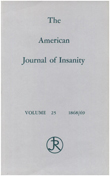Effect of therapeutic innovation on perception of disease and the doctor-patient relationship: a history of general paralysis of the insane and malaria fever therapy, 1910-1950
Abstract
OBJECTIVE: The purpose of this study was to examine the effect of therapeutic innovation on the interpersonal style of physicians by using the historical example of the treatment of general paralysis of the insane by malaria fever therapy. METHOD: The study employed historical qualitative and descriptive methods to analyze medical and popular literature and medical records. These medical records were from a single institution and contained verbatim transcripts of patient interviews and doctors' conferences. The author examined records of patients diagnosed with neurosyphilis from the periods before (1910- 1928) and after (1928-1950) the introduction of malaria fever therapy. RESULTS: Before the introduction of malaria fever therapy, physicians saw their neurosyphilitic patients as "hopeless," "immoral," and "stupid" paretics--objects to be acted upon, a view consistent with the cultural belief that syphilitic patients were sinful and depraved. After the introduction of malaria fever therapy, doctors wrote more positively and empathically about their neurosyphilitic patients, allowing patients to become active participants in their therapeutic regimens. Patients with neurosyphilis voluntarily sought admission specifically for fever therapy, seeing the asylum as a place of cure rather than as an institution of confinement. CONCLUSIONS: This history illustrates that biological therapies can powerfully affect physicians' perceptions of patients and need not remove them from patients' subjective experiences. Instead, biological treatments may enhance physicians' ability to empathize with their patients' suffering.
Access content
To read the fulltext, please use one of the options below to sign in or purchase access.- Personal login
- Institutional Login
- Sign in via OpenAthens
- Register for access
-
Please login/register if you wish to pair your device and check access availability.
Not a subscriber?
PsychiatryOnline subscription options offer access to the DSM-5 library, books, journals, CME, and patient resources. This all-in-one virtual library provides psychiatrists and mental health professionals with key resources for diagnosis, treatment, research, and professional development.
Need more help? PsychiatryOnline Customer Service may be reached by emailing [email protected] or by calling 800-368-5777 (in the U.S.) or 703-907-7322 (outside the U.S.).



